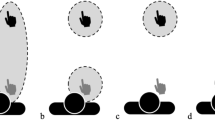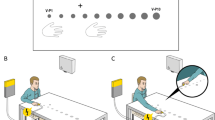Abstract
The representation of the reachable space near the body or peripersonal space (PPS) plays an important role in action with objects and interaction with other people. Here we explored whether the representation of other people’s PPS involves a simulation of their action possibility depending on the distance between the observer's body and the other person. We hypothesized that a simulation of action possibilities of others should be activated when they share the PPS of observers. In two experiments using Immersive Virtual Reality, the avatars were shown with their arms free or blocked (motor interference) at a reachable (i.e., Near/shared PPS) or not-reachable (i.e., Far/not-shared PPS) distance by the participants. Participants had to locate a glass in relation to the midline of the avatar’s body, i.e., assuming the perspective of the avatar. To directly compare the representation of one’s own and others’ PPS, in Experiment 1 participants had to locate the glass in relation to themselves with their arms free or blocked. The glass was always within the PPS of either participants or avatars. The results showed that the localization of the glass from the avatar’s perspective was slower with the blocked than free arm only when the avatar was in the near shared PPS, similar to the localization from one’s own first-person perspective. Instead, there was no effect of motor interference in the far, not-shared PPS. This suggests that the representation of other people’s PPS can involve motor simulation mechanisms when we share a common peripersonal area.





Similar content being viewed by others
Data availability
The authors confirm that the data will be made available on reasonable request.
References
Berti A, Frassinetti F (2000) When far becomes near: remapping of space by tool use. J Cogn Neurosci 12:415–420. https://doi.org/10.1162/089892900562237
Brozzoli C, Makin TR, Cardinali L, Holmes NP, Farné A (2011) Peripersonal space: a multisensory interface for body-object interactions. In: Murray MM, Wallace MT (eds) The neural bases of multisensory processes. Frontiers in Neuroscience. Taylor & Francis, London, pp 449–466
Brozzoli C, Gentile G, Bergouignan L, Ehrsson HH (2013) A shared representation of the space near oneself and others in the human premotor cortex. Curr Biol 23:1764–1768. https://doi.org/10.1016/j.cub.2013.07.004
Caggiano V, Fogassi L, Rizzolatti G, Thier P, Casile A (2009) Mirror neurons differentially encode the peripersonal and extrapersonal space of monkeys. Science 324(5925):403–406. https://doi.org/10.1126/science.1166818
Cardellicchio P, Sinigaglia C, Constantini M (2013) Grasping affordances with the other’s hand: a TMS study. Soc Cogn Affect Neur 8:455–459. https://doi.org/10.1093/scan/nss017
Cardinali L, Brozzoli C, Farnè A (2009) Peripersonal space and body schema: two labels for the same concept? Brain Topogr 21:252–260. https://doi.org/10.1007/s10548-009-0092-7
Cléry J, Guipponi O, Wardak C, Hamed SB (2015) Neuronal bases of peripersonal and extrapersonal spaces, their plasticity and their dynamics: knowns and unknowns. Neuropsychologia 70:313–326. https://doi.org/10.1016/j.neuropsychologia.2014.10.022
Coello Y, Iachini T (2015). Objects and people in space: towards a unified theoretical framework. In: Coello Y and Fischer M (Eds.) Foundations of embodied cognition. Routledge, pp 198–219
Coello Y, Bourgeois J, Iachini T (2012) Embodied perception of reachable space: how do we manage threatening objects? Cogn Process 13:131–135. https://doi.org/10.1007/s10339-012-0470-z
Costantini M, Ambrosini E, Tieri G, Sinigaglia C, Committeri G (2010) Where does an object trigger an action? An investigation about affordances in space. Exp Brain Res 207(1–2):95–103. https://doi.org/10.1007/s00221-010-2435-8
Costantini M, Committeri G, Sinigaglia C (2011) Ready both to your and to my hands: mapping the action space of others. PLoS ONE. https://doi.org/10.1371/journal.pone.0017923
Creem-Regehr SH, Gagnon KT, Guess MN, Stefanucci JK (2013) Relating spatial perspectives to the perception of other’s affordances: providing a foundation for predicting the future behavior of others. Front Hum Neurosci 7:1–14. https://doi.org/10.3389/fnhum.2013.00596
di Pellegrino G, Làdavas E (2015) Peripersonal space in the brain. Neuropsychologia 66:126–133. https://doi.org/10.1016/j.neuropsychologia.2014.11.011
Farnè A, Demattè ML, Làdavas E (2005) Neuropsychological evidence of modular organization of the near peripersonal space. Neurology 65:1754–1758. https://doi.org/10.1212/01.wnl.0000187121.30480.09
Ferri F, Riggio L, Gallese V, Costantini M (2011) Objects and their nouns in peripersonal space. Neuropsychologia 49:3519–3524. https://doi.org/10.1016/j.neuropsychologia.2011.09.001
Fini C, Costantini M, Committeri G (2014) Sharing space: the presence of other bodies extends the space judged as near. PLoS ONE 9(12):e114719. https://doi.org/10.1371/journal.pone.0114719
Fini C, Brass M, Committeri G (2015) Social scaling of extrapersonal space: target objects are judged as closer when the reference frame is a human agent with available movement potentialities. Cognition 134:50–56. https://doi.org/10.1016/j.cognition.2014.08.014
Gallese V (2007) Before and below ‘theory of mind’: Embodied simulation and the neural correlates of social cognition. Philos T R Soc B 362:659–669
Gravetter FJ, Wallnau LB (2014) Introduction to the t statistic. In: Gravetter FJ, Wallnau LB (eds.) Essentials of statistics for the behavioral sciences, 252 (Wadsworth Publishing, 2014)
Graziano M (2017) The spaces between us: a story of neuroscience, evolution, and human nature. Oxford University Press
Graziano MSA, Cooke DF (2006) Parieto-frontal interactions, personal space, and defensive behavior. Neuropsychologia 44:2621–2635. https://doi.org/10.1016/j.neuropsychologia.2005.09.009
Guagnano D, Rusconi E, Umiltà CA (2010) Sharing a task or sharing space? On the effect of the confederate in action coding in a detection task. Cognition 114(3):348–355. https://doi.org/10.1016/j.cognition.2009.10.008
Holmes NP, Spence C (2004) The body schema and the multisensory representation(s) of peripersonal space. Cogn Process 5:94–105. https://doi.org/10.1007/s10339-004-0013-3
Hommel B (2009) Action control according to TEC (theory of event coding). Psychol Res 73:512–526. https://doi.org/10.1007/s00426-009-0234-2
Hommel B, Müsseler J, Aschersleben G, Prinz W (2001) The theory of event coding (TEC): a framework for perception and action planning. Behav Brain Sci 24:849–878. https://doi.org/10.1017/S0140525X01000103
Iachini T, Coello Y, Frassinetti F, Ruggiero G (2014a) Body space in social interactions: a comparison of reaching and comfort distance in immersive virtual reality. PLoS ONE 9(11):e111511. https://doi.org/10.1371/journal.pone.0111511
Iachini T, Ruggiero G, Ruotolo F, Vinciguerra M (2014b) Motor resources in peripersonal space are intrinsic to spatial encoding: Evidence from motor interference. Acta Psychol 153:20–27. https://doi.org/10.1016/j.actpsy.2014.09.001
Iachini T, Pagliaro S, Ruggiero G (2015) Near or far? It depends on my impression: moral information and spatial behavior in virtual interactions. Acta Psychol 161:131–136. https://doi.org/10.1016/j.actpsy.2015.09.003
Iachini T, Coello Y, Frassinetti F, Senese VP, Galante F, Ruggiero G (2016) Peripersonal and interpersonal space in virtual and real environments: effects of gender and age. J Environ Psychol 45:154–164. https://doi.org/10.1016/j.jenvp.2016.01.004
Iachini T, Ruotolo F, Vinciguerra M, Ruggiero G (2017) Manipulating time and space: collision prediction in peripersonal and extrapersonal space. Cognition 166:107–117. https://doi.org/10.1016/j.cognition.2017.03.024
Knoblich G, Sebanz N (2008) Evolving intentions for social interaction: from entrainment to joint action. Philos T R Soc B 363:2021–2031. https://doi.org/10.1098/rstb.2008.0006
Lloyd DM (2009) The space between us: a neurophilosophical framework for the investigation of human interpersonal space. Neurosci Biobehav R 33:297–304. https://doi.org/10.1016/j.neubiorev.2008.09.007
Loomis JM, Knapp JM (2003) Visual perception of egocentric distance in real and virtual environments. Virtual Adapt Environ 11:21–46
Maister L, Cardini F, Zamariola G, Serino A, Tsakiris M (2015) Your place or mine: shared sensory experiences elicit a remapping of peripersonal space. Neuropsychologia 70:455–461. https://doi.org/10.1016/j.neuropsychologia.2014.10.027
Makin TR, Holmes NP, Ehrsson HH (2008) On the other hand: dummy hands and peripersonal space. Behav Brain Res 191:1–10. https://doi.org/10.1016/j.bbr.2008.02.041
Pellencin E, Paladino MP, Herbelin B, Serino A (2018) Social perception of others shapes one’s own multisensory PPS. Cortex 104:163–179. https://doi.org/10.1016/j.cortex.2017.08.033
Richardson MJ, Marsh KL, Isenhower RW, Goodman JR, Schmidt RC (2007) Rocking together: dynamics of intentional and unintentional interpersonal coordination. Hum Movement Sci 26(6):867–891. https://doi.org/10.1016/j.humov.2007.07.002
Rizzolatti G, Fadiga L, Fogassi L, Gallese V (1997) The space around us. Science 277:190–191. https://doi.org/10.1126/science.277.5323.190
Rizzolatti G, Fogassi L, Gallese V (2001) Neurophysiological mechanisms underlying the understanding and imitation of action. Nat Rev Neurosci 2:661–670. https://doi.org/10.1038/35090060
Ruggiero G, Frassinetti F, Coello Y, Rapuano M, Schiano di Cola A, Iachini T (2017) The effect of facial expressions on peripersonal and interpersonal spaces. Psychol Res 81(6):1232–1240. https://doi.org/10.1007/s00426-016-0806-x
Ruggiero G, Rapuano M, Iachini T (2019) Perceived temperature modulates peripersonal and interpersonal spaces differently in men and women. J Environ Psychol 63:52–59. https://doi.org/10.1016/j.jenvp.2019.04.004
Sebanz N, Knoblich G, Prinz W (2003) Representing others’ actions: just like one’s own? Cognition 88:B11-21. https://doi.org/10.1016/S0010-0277(03)00043-X
Sebanz N, Knoblich G, Prinz W (2005) How two share a task: corepresenting stimulus-response mappings. J Exp Psychol Human 31:1234–1246. https://doi.org/10.1037/0096-1523.31.6.1234
Sebanz N, Bekkering H, Knoblich G (2006) Joint action: bodies and minds moving together. Trends Cogn Scie 10(2):70–76. https://doi.org/10.1016/j.tics.2005.12.009
Sirigu A, Duhamel JR (2001) Motor and visual imagery as two complementary but neurally dissociable mental processes. J Cogn Neurosci 13(7):910–919. https://doi.org/10.1162/089892901753165827
Stevens JA (2005) Interference effects demonstrate distinct roles for visual and motor imagery during the mental representation of human action. Cognition 95:329–350. https://doi.org/10.1016/j.cognition.2004.02.008
Tabachnick BG, Fidell LS (1996) Using multivariate statistics, 3rd edn. Harper Collins, New York
Teneggi C, Canzoneri E, di Pellegrino G, Serino A (2013) Social modulation of peripersonal space boundaries. Curr Biol 23:406–411. https://doi.org/10.1016/j.cub.2013.01.043
Wolpert DM, Doya K, Kawato M (2003) A unifying computational framework for motor control and social interaction. Philos T R Soc B 358(1431):593–602. https://doi.org/10.1098/rstb.2002.1238
Author information
Authors and Affiliations
Corresponding author
Ethics declarations
Conflict of interest
The corresponding author (Iachini, T.) declares that she has no conflict of interest, as well as co-author (Ruggiero, G.).
Ethical approval
The authors also declare that all procedures performed in studies involving human participants were in accordance with the ethical standards of the institutional research committee (i.e., Ethical Committee of the Department of Psychology, University of Campania “L. Vanvitelli”) and with the 1964 Helsinki Declaration and its later amendments or comparable ethical standards. Furthermore, informed consent was obtained from all individual participants included in the study. Finally, this article does not contain any studies with animals performed by any of the authors.
Additional information
Communicated by Francesca Frassinetti.
Publisher's Note
Springer Nature remains neutral with regard to jurisdictional claims in published maps and institutional affiliations.
Rights and permissions
About this article
Cite this article
Iachini, T., Ruggiero, G. Can I put myself in your shoes? Sharing peripersonal space reveals the simulation of the action possibilities of others. Exp Brain Res 239, 1035–1045 (2021). https://doi.org/10.1007/s00221-021-06040-9
Received:
Accepted:
Published:
Issue Date:
DOI: https://doi.org/10.1007/s00221-021-06040-9




